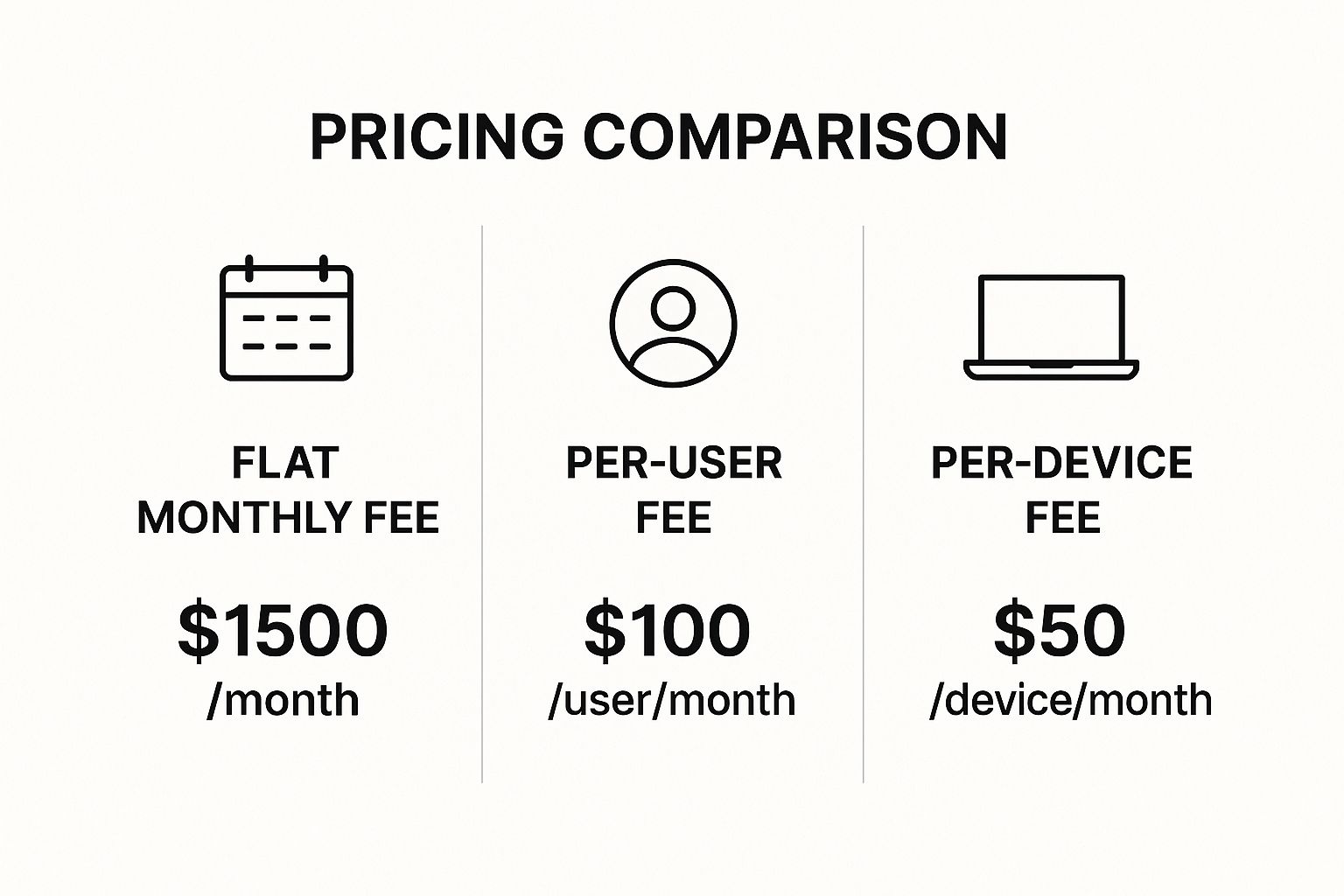Demystifying Managed IT Services Pricing Models
Understanding managed IT services pricing can be challenging. However, grasping the core pricing models makes informed IT investment decisions much easier. Several common approaches exist, each with advantages and disadvantages. These include per-user, per-device, tiered, and à la carte pricing. The right model depends on your business needs and technology usage.
Common Managed IT Services Pricing Structures
Let's examine each model. Per-user pricing charges a fixed monthly fee per user. This simplifies budgeting, especially for businesses with stable workforces. Per-device pricing charges a fixed monthly fee per managed device. This benefits companies with numerous devices or shared workstations.
Tiered pricing offers packaged service levels, from basic monitoring to comprehensive support. Businesses choose the tier aligning with their needs and budget. À la carte pricing provides maximum flexibility. Companies select specific services and pay for each individually.

This infographic compares three common pricing examples: a flat monthly fee, a per-user fee, and a per-device fee. The most cost-effective option depends on your business size and structure. Smaller companies might find per-user or per-device models more attractive, while larger organizations may benefit from a flat monthly fee.
To understand pricing variations, let's examine real-world data. Managed IT services pricing varies considerably. Per-user pricing averages between $175 and $250 per user per month. Per-device pricing ranges from $30 to $100 per device. Tiered pricing packages typically cost between $3,000 and $6,000 per month. À la carte services range from $30 to $100 per user or device per service. For more detailed statistics, visit Cyber Command.
The following table summarizes the key features of each pricing model:
Comparison of Managed IT Services Pricing Models
| Pricing Model | Average Cost Range | Best For | Advantages | Potential Drawbacks |
|---|---|---|---|---|
| Per-User | $175-$250/user/month | Businesses with a predictable number of users | Simple budgeting, predictable costs | Can be expensive for companies with a high user-to-device ratio |
| Per-Device | $30-$100/device/month | Businesses with a high device-to-user ratio or numerous devices | Cost-effective for companies with shared workstations | Can become expensive as the number of devices increases |
| Tiered | $3,000-$6,000/month | Businesses seeking bundled services and predictable monthly costs | Comprehensive service packages, predictable spending | May include services a business doesn't need |
| À la Carte | $30-$100/service/user/device | Businesses with unique IT requirements | Flexible, customizable, only pay for what you need | Can be difficult to budget, costs can escalate if not carefully managed |
This table provides a quick overview of each model's cost, suitability, benefits, and potential downsides. Understanding these factors is crucial for selecting the right model.
Navigating the Pricing Landscape
Each model has its ideal use case. Per-user pricing suits businesses with predictable user bases, while per-device pricing benefits companies with high device-to-user ratios. Tiered pricing caters to businesses seeking bundled services and predictable costs. À la carte pricing allows customization and paying only for necessary services, ideal for unique IT requirements. Resources like the Seat Leasing BPO Service Sitemap can help businesses explore further IT solutions. Understanding these nuances allows informed decisions and selecting cost-effective models.
The Evolution of IT Service Pricing: Past to Present

The way businesses pay for IT support has changed drastically over time. Initially, the break-fix model was the standard. Much like calling a plumber for a broken pipe, businesses only paid when something went wrong. This reactive approach resulted in unpredictable expenses and often extensive downtime.
This made budgeting difficult and hampered long-term planning. Businesses were constantly reacting to IT issues instead of focusing on strategic growth. The break-fix model made it challenging to allocate resources effectively.
The Rise of Managed Services and Predictable Pricing
As technology became more critical to business operations, a new model arose: managed IT services. This model shifted the focus from reaction to prevention. Managed service providers (MSPs) proactively monitor systems, apply updates, and address potential vulnerabilities before they become major problems.
This proactive approach leads to increased uptime, improved security, and predictable monthly costs. Predictable pricing allows for better budgeting and resource allocation. Businesses can focus on their core operations, knowing their IT infrastructure is being managed effectively.
The Shift to Value-Based Pricing
This evolution in managed IT services pricing reflects a broader shift in how businesses view technology. It's now seen as a strategic investment, not just an expense. Understanding various subscription pricing strategies is vital for managed IT services.
Historically, pricing has changed significantly. Recently, managed IT services in the US and Canada have ranged from $150 to $400 per user, per month. This range accommodates the diverse needs of businesses, from basic monitoring to comprehensive IT support. Learn more about managed IT services pricing.
From Per-Device to Per-User and Beyond
Pricing structures have also become more sophisticated. While per-device pricing was common initially, the per-user model has become more prevalent. This model simplifies billing and aligns costs with the number of employees using IT resources.
For example, a company with 30 employees would pay for 30 users, irrespective of their device count. Variations exist, however, with some MSPs offering tiered pricing based on service levels or à la carte options for specific needs. This allows businesses to customize their IT services and pay only for what they need.
This evolution in managed IT services pricing highlights the increasing importance of technology for business success. Understanding these trends and current pricing models empowers companies to make informed decisions that align IT spending with business goals. This strategic approach ensures that IT investments contribute to overall business growth and efficiency.
Hidden Factors Driving Your Managed IT Services Costs

While understanding the basic pricing models for managed IT services is important, several less obvious factors can significantly influence your total cost. These hidden factors can sometimes make budgeting a challenge, so it's essential to be aware of them before signing a contract.
Compliance Requirements and Their Cost Implications
One key factor is industry-specific compliance. If your business operates in a regulated industry like healthcare or finance, you'll likely have stricter IT requirements. For example, meeting HIPAA or PCI DSS standards often necessitates more robust security measures, increasing your managed IT services costs.
These added costs stem from things like advanced security software, more frequent audits, and specialized staff training. Understanding your industry's specific regulations is crucial for accurate budgeting.
The Complexity of Your Technical Environment
Another factor is the complexity of your existing IT environment. A business with a complex network infrastructure, numerous software applications, and a variety of devices will typically require more extensive management and support. This increased complexity translates to higher managed IT services pricing.
For instance, managing a network with legacy systems can be far more time-consuming and costly than managing a modern, cloud-based infrastructure. Older systems often require specialized expertise and may be more vulnerable to security threats.
Support Expectations and Service Level Agreements
Your support expectations also play a role in managed IT services pricing. The level of support you require, outlined in your Service Level Agreement (SLA), will directly impact the cost.
Do you need 24/7 support? What are your expected response times for critical incidents? A higher level of support, such as guaranteed response times within minutes, naturally commands a higher price than basic business-hour support. Defining your needs upfront is essential for controlling costs.
Onboarding, Escalation Clauses, and Customizations
Other hidden cost drivers include onboarding complexity, contract escalation clauses, and customizations. Onboarding a new client onto a managed IT services platform can be a complex process, especially if migrating from an existing system. This initial setup can incur additional costs.
Additionally, be mindful of escalation clauses in your contract that might automatically increase pricing after a certain period. Finally, while customizations can be valuable, they often add to the overall cost. It’s important to differentiate between customizations that genuinely add value and those that simply inflate your bill.
Successfully managing managed IT services pricing requires understanding these hidden factors and proactively addressing them during the negotiation process. This ensures you receive the services you need at a price that aligns with your budget and business objectives.
Calculating Real ROI From Your IT Services Investment

Many businesses view managed IT services as just another cost. However, forward-thinking organizations understand that effective IT services are a strategic investment. They recognize that IT can drive significant returns. This requires a shift in perspective, from focusing on expense to recognizing value creation. But how can this value be measured?
Measuring Tangible and Intangible Returns
Calculating the Return on Investment (ROI) from managed IT services requires assessing both tangible and intangible benefits. Tangible benefits are easily measured, such as cost savings from minimizing downtime. For example, if your managed services provider prevents a server outage that would have cost your business $10,000, that's a clear and quantifiable return.
Intangible benefits are more challenging to measure but just as crucial. These include enhanced security, improved employee productivity, and streamlined regulatory compliance. While not directly tied to a specific dollar figure, these benefits significantly impact the overall success of your business. Effectively communicating the full value of managed IT services to stakeholders is essential.
Managed Service Providers (MSPs) play a critical role in boosting productivity and mitigating risks. Studies have shown that MSPs can increase productivity by 15-25% through improved efficiency and reduced downtime. Furthermore, they can decrease the risk of cyberattacks by up to 50%. This not only provides financial benefits but also strengthens a business's overall cybersecurity posture. More detailed statistics can be found here. Investing in robust IT services can therefore offer significant returns through enhanced operational efficiency and risk mitigation. You might also find this interesting: How to master…
Frameworks for ROI Calculation
There are various frameworks for calculating the ROI of managed IT services. One common method involves tracking key performance indicators (KPIs) related to productivity, downtime, security incidents, and operational efficiency. By monitoring these KPIs before and after implementing managed services, you can effectively measure the impact of your investment. The following table illustrates potential ROI metrics.
To illustrate the potential return on investment from Managed IT Services, consider the following table:
ROI Metrics for Managed IT Services
This table presents key performance indicators and metrics businesses can use to measure the return on investment from their managed IT services expenditure.
| Benefit Category | Key Metrics | Average Improvement | Financial Impact |
|---|---|---|---|
| Productivity | Employee output per hour, project completion time | 15-25% increase | Reduced labor costs, increased revenue |
| Downtime | System availability, incident resolution time | 20-40% reduction | Minimized lost revenue, improved customer satisfaction |
| Security | Number of security incidents, data breach costs | Up to 50% reduction | Reduced financial losses, protected reputation |
| Operational Efficiency | IT support costs, automation of routine tasks | 10-20% cost reduction | Lower operating expenses, freed-up resources for strategic initiatives |
As this table indicates, the potential financial impact of managed IT services can be substantial. From increased productivity and reduced downtime to enhanced security and improved operational efficiency, the benefits contribute to a healthier bottom line.
Presenting IT Investments to Leadership
When presenting IT investments to leadership, focus on the strategic value they provide. Instead of emphasizing the cost of managed services, highlight the potential cost avoidance from averted security breaches and minimized downtime. Quantify the improvements in productivity and efficiency. Explain how a strong IT infrastructure empowers business growth and enhances competitiveness. This approach frames the conversation in terms of value, demonstrating how managed IT services directly contribute to achieving overall business objectives.
Creating a Strategic Managed IT Services Budget
Transitioning from a reactive IT budget to a strategic one requires careful planning and execution. This shift means moving away from simply addressing IT issues as they arise and instead proactively allocating resources for optimal performance and future growth. A strategic budget empowers you to anticipate future needs and make more informed IT decisions. Understanding the return on investment is crucial when budgeting for managed IT services. For a detailed analysis, see this article about the ROI of AI in Customer Service.
Assessing Your Current IT Ecosystem
The first step in developing a strategic managed IT services budget is to thoroughly assess your current technology landscape. This assessment should include a complete inventory of your existing hardware, software, and network infrastructure. Identifying outdated systems and potential vulnerabilities is key to this process. For instance, are you using legacy software that requires expensive upkeep? Are there security gaps that need immediate attention? This evaluation provides a clear picture of your existing IT spending and highlights areas for potential improvement.
Identifying Critical Service Requirements
Next, determine which managed IT services are essential for your business operations. Prioritize your IT needs based on factors like security, compliance, and productivity. Some organizations might require 24/7 support, while others may only need coverage during standard business hours. Consider your industry’s specific compliance requirements. For example, businesses in healthcare must comply with HIPAA regulations, potentially necessitating specialized security measures. Prioritizing these needs will allow you to efficiently allocate resources.
Projecting Future IT Needs
Looking ahead is a critical component of a strategic IT budget. Projecting future IT needs, based on anticipated business growth, is essential for long-term success. This involves understanding how your technology requirements will change as your business expands. Will you need to expand your current network infrastructure? Are you planning to integrate new software applications? Considering these future needs ensures your IT budget aligns with your broader business strategy.
Establishing Spending Thresholds and Prioritizing Investments
Once you’ve assessed your present and future IT needs, you can establish appropriate spending thresholds. This involves setting realistic financial limits for different IT spending categories. For instance, what portion of your budget should be dedicated to security compared to support? Prioritizing investments within these thresholds is also essential. This might involve choosing cloud-based solutions to lower hardware costs or implementing automation tools like Zapier or Make to enhance efficiency. Strategic decisions like these will maximize the impact of your IT spending.
Creating a Flexible IT Budget
Finally, incorporate flexibility into your IT budget. This means creating a budget that can adapt to unexpected challenges or opportunities. You might consider setting aside a contingency fund for unforeseen expenses or designing the budget with the ability to adjust spending when necessary. This flexibility will allow you to effectively respond to changing market conditions or the emergence of new technologies. Ultimately, it ensures your business remains agile and adaptable in unpredictable circumstances. A flexible budget is a critical tool for navigating the dynamic IT landscape.
Winning the Managed IT Services Negotiation Game
Negotiating managed IT services contracts can be a challenging process. But with the right preparation and strategy, you can secure terms that benefit your business and fit within your budget. This involves understanding which contract elements are negotiable and which are typically standard. It also requires knowing how to spot potentially problematic contract language.
Key Negotiable Elements in Managed IT Services Contracts
Many aspects of managed IT services contracts are open for discussion. Pricing is a key area of focus. Explore options like volume discounts if you have a significant number of users or devices. Contract length is also negotiable. Longer contracts may offer lower monthly rates, while shorter terms offer more flexibility. Service Level Agreements (SLAs) can also be tailored to your needs. Guaranteed response times are crucial, but you can negotiate specific metrics aligned with your business's operational requirements and risk tolerance.
For instance, instead of requiring immediate responses for every issue, consider negotiating tiered response times based on incident severity. This tiered approach can manage costs while ensuring critical issues are addressed promptly. You might find this resource helpful: How to master…
Non-Negotiable Industry Standards
While many contract elements are flexible, certain industry standards are typically non-negotiable. Security protocols, often mandated by regulations, fall into this category. Attempting to negotiate these could weaken your security posture. Similarly, core services like system monitoring and patching are generally standard practice.
Strategies for Effective Negotiation
Effective negotiation begins with understanding your business needs and budget. Before starting negotiations, clearly define your essential services, desired features, and acceptable cost range. This preparation enables you to make informed decisions and avoid being swayed by attractive offers that don't fully meet your requirements.
Carefully compare proposals, paying attention to the details beyond the initial price. Compare SLAs, included services, and contract terms. A lower monthly fee might hide additional costs or limitations in service coverage. This thorough comparison ensures you are evaluating proposals on an equal footing.
Identifying Concerning Contract Language
Be mindful of vague or excessively broad language. Clauses that allow the provider to unilaterally change pricing or service levels without your consent should be carefully reviewed. Similarly, be cautious of automatic renewal clauses that lock you into extended agreements without a clear exit strategy. A thorough review of contract language protects your business interests.
Mid-Contract Adjustments and Building Collaborative Partnerships
Negotiation isn't a one-time event. Your business needs may change. A good managed IT services provider will be open to discussing mid-contract adjustments to keep your agreement aligned with your evolving objectives.
Negotiating managed IT services contracts should be a collaborative process, not a competition. The goal is to build a strong partnership with your technology provider. A mutually beneficial agreement ensures your IT infrastructure is well-managed while staying within your budget. This approach lays the foundation for a successful long-term relationship.
Ready to experience the advantages of a strategically managed workspace? Learn more about how Seat Leasing BPO can support your business growth.




